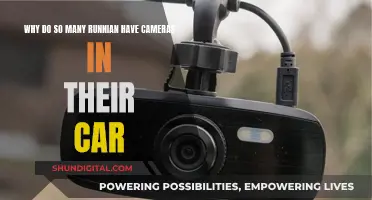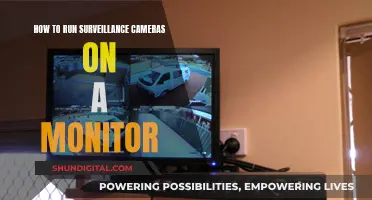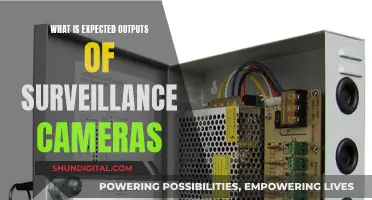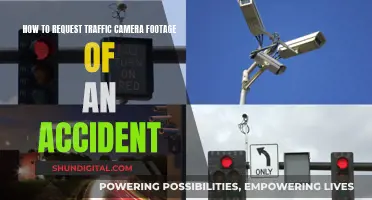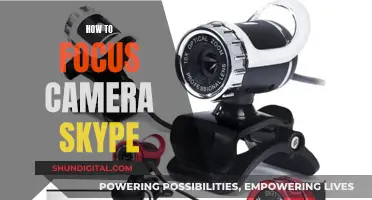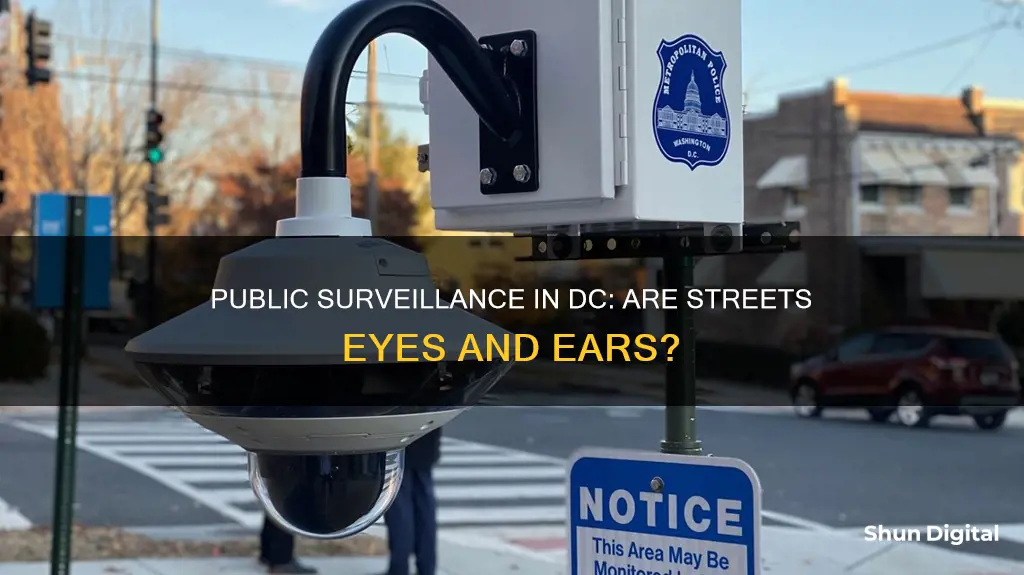
The Metropolitan Police Department in Washington, D.C. operates a network of CCTV cameras to support public safety operations in the city. The cameras are primarily located in downtown DC, monitoring public spaces around critical installations such as the National Mall, the US Capitol, the White House, and Union Station. They are also positioned along major arteries and highways that pass through the city. The stated purpose of the CCTV system is to enhance public safety and security while respecting individuals' privacy rights. The cameras are not equipped with audio capabilities or biometric technology, and regulations prohibit their use for infringing on First Amendment rights or arbitrary monitoring based on race, gender, or other factors. The system is not monitored constantly but is activated during major events or periods of heightened alert for terrorism.
| Characteristics | Values |
|---|---|
| Purpose | To support public safety operations, manage public resources during major public events and demonstrations, coordinate traffic control, and combat crime in District neighborhoods |
| Privacy | The primary goal is to enhance the safety and security of residents, workers, and visitors while respecting the privacy rights of individuals. The CCTV network provides video images of public spaces only and is not equipped with audio capabilities. |
| Camera Locations | National Mall, US Capitol, White House, Union Station, other critical installations, major arteries and highways in downtown DC and the District of Columbia |
| Camera Types | Permanent Cameras, Neighborhood-Based Cameras |
| Camera Features | 360-degree pan, 180-degree tilt, zoom capabilities |
| Camera Operation | The system is not a round-the-clock monitoring operation. It is activated during major events or periods of heightened alert for terrorism. |
| Camera Footage Usage | Footage is used to gather information for investigations, showing the paths and directions taken by suspects and witnesses following incidents. |
| Camera Footage Access | Footage can be accessed by submitting a request for a Traffic Safety Assessment or through the Photo Enforcement Moving Violations Public Inquiry Portal with a ticket number and PIN. |
What You'll Learn

Locations of surveillance cameras in DC
The Metropolitan Police Department (MPD) in Washington, D.C., operates a network of surveillance cameras to support public safety operations in the district. The MPD's Closed Circuit Television (CCTV) system includes both neighbourhood-based and permanent cameras.
Neighbourhood-Based Cameras
The MPD has deployed neighbourhood-based cameras in all seven Police Districts. These cameras are designed to be flexible and can be moved according to crime trends and community concerns.
Some of the locations of neighbourhood-based cameras in Washington, D.C., include:
- 1st Street, NW and L Street, NW
- 1st Place, NW and M Street, NW
- 11th Street, SE and K Street, SE
- 12th Street, SE and Pennsylvania Avenue, SE
- 1st Street, NW and Pierce Street, NW
- 5th Street, NW and K Street, NW
- 7th Street, NW and H Street, NW
- 1st Street, SW and P Street, SW
- 1724 Independence Avenue, SE
- 3rd Street, SW and O Street, SW
- 1001 19th St N, Arlington, VA (on the rooftop)
- 1st Street, SW and V Street, SW (HS)
- 3rd Street, NW and Constitution Avenue, NW (on the rooftop)
- 490 L’Enfant Plaza SW (on the rooftop)
- North Capitol Street, NW and F Street, NW (on the rooftop)
- Half St and S Street, SW (on the rooftop)
- 12th Street, SE and K Street, SE
- 14th Street, SE and Potomac Avenue, SE
- 6th Street, NE and Maryland Avenue, NE
- 15th Street, SE and Independence Avenue, SE
- 11th Street, NE and H Street, NE
- 14th Street, NW and P Street, NW
- 14th Street, NW and Girard Street, NW
- 1st Street, NE and Webster Street, NE
- 5th Street, NW and Kennedy Street, NW
- 7th Street, NW and Kennedy Street, NW
- 8th Street, NW and Jefferson Street, NW
- 14th Street, NW and V Street, NW
Permanent Cameras
The MPD also operates a network of permanent CCTV cameras, primarily located in downtown DC. These cameras focus on public spaces around critical installations such as the National Mall, the US Capitol, the White House, and Union Station.
Some of the locations of permanent cameras in Washington, D.C., include:
- 1st and V Streets, SW
- 200 block of Constitution Avenue, NW
- 300 block of Independence Avenue, SW
- 400 block of L'Enfant Plaza, SW
- 500 block of North Capitol Street, NW
- Half and S Streets, SW
- South Capitol Street and Potomac Avenue, SW
- 7th Street and Pennsylvania Avenue, SE
- 7th Street and I Street, SW
- 1000 block of Vermont Avenue, NW
- 1100 block of Pennsylvania Ave, NW
- 1300 block of Wisconsin Avenue, NW
- 18th and G Streets, NW
- 19th Street and Dupont Circle, NW
- 20th and G Streets, NW
- 3600 block of M Street, NW
- 5400 block of Norton Street, NW
- 5900 block of MacArthur Boulevard, NW
- 700 block of 18th Street, NW
- 800 block of Vermont Ave, NW
- Connecticut Avenue and N Street, NW
- Pennsylvania Avenue and 15th Street, NW
- Wisconsin Avenue & M Street, NW (Banana Republic)
- 1st and Bryant Streets, NW
- 7th Street SE and Pennsylvania Avenue, SE
- 14th Street and Missouri Avenue, NW
- 4th Street and Cedar Street, NW
- North Capitol Street and P Street, NW
- 21st Street and Bennett Place, NE
- 18th Street and Benning Road, NE
- 600 block of Anacostia Avenue, NE
- Benning Road and Anacostia Avenue, NE
- Kenilworth Avenue and Foote Street, NE
- 2600 block of Good Hope Road, SE
- 44th Street and Blaine Street, NE
- Minnesota Avenue and Nash Place, SE
- 13th Street and Congress Street, SE
- 25th Street and Savannah Street, SE
- Atlantic Street and Valley Avenue, SE
- Stanton Road and Sheridan Road, SE
Focus Camera: Online Presence and Website Availability
You may want to see also

CCTV system operations and capabilities
The Metropolitan Police Department (MPD) operates a Closed-Circuit Television (CCTV) system to support public safety operations in Washington, D.C. The network consists of 19 permanent cameras, primarily located in the downtown DC area. The cameras are mounted on buildings and focus on public spaces such as the National Mall, the US Capitol, the White House, Union Station, and other critical installations. They also cover major arteries and highways passing through downtown DC.
The CCTV system is not used for constant monitoring. Instead, it is activated during significant events or periods of heightened alert, such as large-scale demonstrations, the Fourth of July celebrations, presidential inaugurations, or major investigations. The system helps law enforcement monitor public spaces during these events without deploying a large number of officers. It also assists in efficiently deploying resources and responding to incidents more effectively.
The cameras can pan 360 degrees and tilt 180 degrees, and while they can zoom in on specific locations, their primary purpose is to monitor wide areas of public space rather than individuals. The MPD respects privacy rights, and the CCTV network only provides video footage of public spaces without audio. Both DC regulations and internal MPD policy prohibit arbitrary monitoring based on race, gender, or other factors and protect First Amendment rights.
The MPD notifies the public about the capabilities and uses of the CCTV system, and signs indicate the locations of the permanent cameras. The Department also provides regular reports on CCTV usage and seeks public comment before expanding the network.
Reputable Camera Retailers: Focus Camera's Trustworthy Service
You may want to see also

Automated Traffic Enforcement Camera Locations
The District of Columbia (DC) has a complicated relationship with surveillance cameras. While they are valued by many residents as a tool to improve safety and reduce crashes and fatalities, they are also controversial, with some drivers and councilmembers questioning whether the cameras are more about generating revenue than saving lives.
Automated Traffic Enforcement Cameras are used in DC to enforce red-light and speed limits. The locations of these cameras are decided upon by the DC Department of Transportation's Traffic Safety Input program.
- 1st and V Streets, SW
- 200 block of Constitution Avenue, NW
- 300 block of Independence Avenue, SW
- 400 block of L'Enfant Plaza, SW
- 500 block of North Capitol Street, NW
- Half and S Streets, SW
- South Capitol Street and Potomac Avenue, SW
- 7th Street and Pennsylvania Avenue, SE
- 7th Street and I Street, SW
- 1000 block of Vermont Avenue, NW
- 1100 block of Pennsylvania Ave, NW
- 1300 block of Wisconsin Avenue, NW
- 18th and G Streets, NW
- 18th and H Streets, NW
- 19th and G Streets, NW
- 19th and H Streets, NW
- 19th Street and Dupont Circle, NW
- 20th and G Streets, NW
- 20th and H Streets, NW
- 3600 block of M Street, NW
- 5400 block of Norton Street, NW
- 5900 block of MacArthur Boulevard, NW
- 700 block of 18th Street, NW
- 700 block of 19th Street, NW
- 800 block of Vermont Ave, NW
- Connecticut Avenue and N Street, NW
- Pennsylvania Avenue and 15th Street, NW
- Wisconsin Avenue & M Street, NW (Banana Republic)
- Connecticut Avenue and Albemarle Street, NW
- 1st and Bryant Streets, NW
- 7th Street SE and Pennsylvania Avenue, SE
- 7th Street and T Street, NW
- 14th Street and Missouri Avenue, NW
- 4th Street and Cedar Street, NW
- North Capitol Street and P Street, NW
- 21st Street and Bennett Place, NE
- 18th Street and Benning Road, NE
- 600 block of Anacostia Avenue, NE
- Benning Road and Anacostia Avenue, NE
- Kenilworth Avenue and Foote Street, NE
- 2600 block of Good Hope Road, SE
- 44th Street and Blaine Street, NE
- Minnesota Avenue and Nash Place, SE
- 13th Street and Congress Street, SE
- 25th Street and Savannah Street, SE
- Atlantic Street and Valley Avenue, SE
- Stanton Road and Sheridan Road, SE
- 1000 block of 19th Street, North (Arlington/Rosslyn, VA)
In addition to the permanent CCTV cameras, there are also neighborhood-based CCTV cameras designed to help combat crime in specific DC neighborhoods.
Kodak Camera Battery: How to Spot a Bad One
You may want to see also

Permanent and neighbourhood-based cameras
In 2006, the Metropolitan Police Department began deploying Closed-Circuit Television (CCTV) cameras to help combat crime in the District of Columbia. There are 48 permanent CCTV cameras in DC, located at major intersections and streets across the city. These cameras are positioned to monitor traffic and enhance public safety.
The locations of the permanent CCTV cameras in DC include:
- 1st and V Streets, SW
- 200 block of Constitution Avenue, NW
- 300 block of Independence Avenue, SW
- 400 block of L'Enfant Plaza, SW
- 500 block of North Capitol Street, NW
- Half and S Streets, SW
- South Capitol Street and Potomac Avenue, SW
- 7th Street and Pennsylvania Avenue, SE
- 7th Street and I Street, SW
- 1000 block of Vermont Avenue, NW
- 1100 block of Pennsylvania Avenue, NW
- 1300 block of Wisconsin Avenue, NW
- 18th and G Streets, NW
- 18th and H Streets, NW
- 19th and G Streets, NW
- 19th and H Streets, NW
- 19th Street and Dupont Circle, NW
- 20th and G Streets, NW
- 20th and H Streets, NW
- 3600 block of M Street, NW
- 5400 block of Norton Street, NW
- 5900 block of MacArthur Boulevard, NW
- 700 block of 18th Street, NW
- 700 block of 19th Street, NW
- 800 block of Vermont Avenue, NW
- Connecticut Avenue and N Street, NW
- Pennsylvania Avenue and 15th Street, NW
- Wisconsin Avenue and M Street, NW (Banana Republic)
- Connecticut Avenue and Albemarle Street, NW
- 1st and Bryant Streets, NW
- 7th Street, SE and Pennsylvania Avenue, SE
- 7th Street and T Street, NW
- 14th Street and Missouri Avenue, NW
- 4th Street and Cedar Street, NW
- North Capitol Street and P Street, NW
- 21st Street and Bennett Place, NE
- 18th Street and Benning Road, NE
- 600 block of Anacostia Avenue, NE
- Benning Road and Anacostia Avenue, NE
- Kenilworth Avenue and Foote Street, NE
- 2600 block of Good Hope Road, SE
- 44th Street and Blaine Street, NE
- Minnesota Avenue and Nash Place, SE
- 13th Street and Congress Street, SE
- 25th Street and Savannah Street, SE
- Atlantic Street and Valley Avenue, SE
- Stanton Road and Sheridan Road, SE
- 1000 block of 19th Street, North (Arlington/Rosslyn, VA)
The Metropolitan Police Department (MPD) ensures that the public is informed about the capabilities and uses of the CCTV system. Notices are posted near the cameras, indicating their presence. The MPD also provides regular reports on CCTV usage and welcomes public input on any proposed expansion of the network.
Understanding Tapo Camera's Home and Away Modes
You may want to see also

Privacy rights and the CCTV network
In 2006, the Metropolitan Police Department (MPD) began deploying Closed-Circuit Television (CCTV) cameras in Washington, DC, to help combat crime in District of Columbia neighborhoods. The CCTV network consists of 19 permanently installed cameras, with additional cameras added on a temporary or permanent basis following a period of public comment. The cameras are mounted on various buildings, primarily in the downtown DC area, and focus on public spaces and major arteries and highways.
The MPD has developed comprehensive policies and procedures to regulate the use of the CCTV system and guard against possible abuse. The CCTV system is not a round-the-clock monitoring operation but is activated only during major events or emergencies with authorization from the Chief of Police or their designee. The system is tightly regulated, meeting the criminal justice video surveillance guidelines adopted by the American Bar Association.
The CCTV cameras are not equipped with audio capabilities, and the MPD will not use any audio system in conjunction with the CCTV network without appropriate court orders. The cameras can pan at 360 degrees and tilt at 180 degrees and can zoom in on particular locations, but they are used primarily to monitor wide areas of public space, not individuals. The CCTV system does not use face-recognition or any other biometric technology.
The MPD notifies the public about the capabilities and uses of the CCTV system. Signs have been posted to indicate where the permanent cameras are deployed. The department provides regular reports on CCTV usage and seeks public comment on any proposed expansion of the network. Unauthorized use or misuse of the CCTV system will result in disciplinary action.
The CCTV system is designed to ensure the protection of personal privacy rights. It provides video images of public spaces only and is used to observe locations that are in public view, where there is no reasonable expectation of privacy. Both DC regulations and internal MPD policy expressly prohibit the arbitrary monitoring of individuals or monitoring based on race, gender, or other protected factors. The regulations and policies also prohibit the use of the CCTV system for infringing on First Amendment rights.
Trail Camera Evolution: The First Steps
You may want to see also
Frequently asked questions
Yes, the Metropolitan Police Department (MPD) has a network of 19 permanently installed CCTV cameras in public spaces around the National Mall, the US Capitol, the White House, Union Station, and other critical installations.
The primary goal of the CCTV system is to enhance the safety and security of residents, workers, and visitors in the District of Columbia while respecting the privacy rights of individuals. The cameras are used to monitor wide areas of public space and help manage public resources during major events and demonstrations, coordinate traffic control, and combat crime in neighbourhoods.
The cameras are mounted on various buildings, mainly in the downtown DC area, including:
- National Mall
- US Capitol
- White House
- Union Station
- Major arteries and highways passing through downtown DC
A full list of camera locations can be found on the MPD's website.
The CCTV cameras provide video images of public spaces only and do not have audio capabilities. The cameras can pan at 360 degrees and tilt at 180 degrees, and while they can zoom in on particular locations, they are primarily used to monitor wide areas. The system is not a round-the-clock operation and is only activated during major events or periods of heightened alert.


